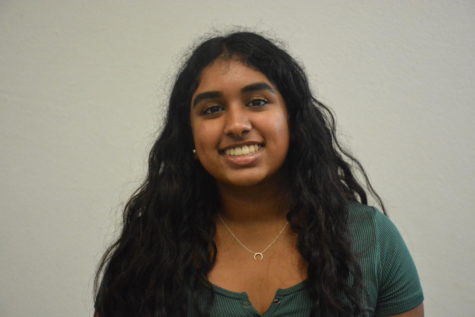Students find passion in athletic training
While, athletic trainer and junior Smriti Balasubramanian helps football players during practice on Sept 30, Jake Madaj (#3) gets his hand wrapped by athletic trainer Katelyn Bishop.
March 9, 2023
As the first half of the football game comes to an end, the team runs to the sidelines of the field, exhausted from the last 15 minutes. Haley Roth, athletic trainer and senior, holds up a case with water bottles, ready to help players prepare for the third quarter.
Sports are a prominent component of the high school community and there are many aspects that create the backbone of a sports season. One of these is the Athletic Trainer Student Aide (ATSA) program, a group of students who are knowledgeable in sports medicine and assist Katelyn Bishop, the official athletic trainer, during games and practices.
“To be an ATSA you have to take sports medicine or a different health related class and submit an application to Bishop,” athletic trainer and senior Saniyah Manaal said. “Most importantly, you should be willing to learn, because being an ATSA is a real hands-on experience and is really interesting if you’re willing to be receptive to learning from the athletic trainers and your experiences on the field.”
Apart from having knowledge about sports medicine, an ATSA should be able to commit extra time after school to the program, since each student may have to help up to three times a week, from possibly 3 p.m. to sometimes as late as 11 p.m. on a game day, especially during football season. Students also need to be quick on their feet because injuries can happen at any time and they should be able to take initiative and speak up while getting organized. Each day looks different for an ATSA, as games, practices and injuries occur randomly, and trainers have to react to these conditionally.
“After the bell rings, I head to the athletic training room immediately to start treatment, rehab and other various athlete care,” Roth said. “Between 3 p.m. and 4:30 p.m. the athletic training room is usually pretty busy, but craziness is dependent on what sports are in season and what games are happening that day.”
During the first hour after the last school bell rings, trainers focus on modalities and physical therapy with athletes who are waiting in the trainer’s room. Some other patient-focused prep done during this time is wound care, stretching, rehab, general athletic training room care and restocking. This variety of activities gives students a window of experience into the world of physical therapy, athletic training and several other medical professions.
“I chose to be an ATSA because I’ve been seeing the trainers since freshman year and I just thought it would be really cool to be a part of this and learn the basics of sport medicine,” athletic trainer and senior Nikita Sirigiri said. “Since I hope to work in orthopedics or athletic training when I grow up, I know that this will allow me to have some experience in the field before I graduate high school.”
When aiding sports, wrestling is much different from every other sport because there are time limits on injury clocks. ATSAs have to be prepped and ready to treat anything from blood to cramps to passing out, all of which are timed. Because of this, wrestling prep primarily consists of having blood buckets that are fully stocked with supplies like nose plugs, gauze, gloves, various adhesives and covers.
“It’s pretty fun to assist and overlook wrestling meets, since they’re fast paced and we get to experience a lot in a short period of time,” Sirigiri said. “A lot of wrestlers get bloody noses or scratches and we have a time limit to fix the issues so it can sometimes be stressful.”
For less contact sports like volleyball and basketball, ATSAs spend less time preparing as they are there only in case of injury or emergency. However, when preparing for football, the trainers have to set up the field, do turf tape for the team, tape and treat injuries and set up a lot of prep for injury or time outs.
“My favorite sport to assist was football because it is the only sport that I was truly on the field and with the players,” Manaal said. “It was a never seen before experience of being that close to a game, getting in on the cheer and intensity of the game and especially being able to help our team.”
The ATSA program allows students with similar interests to work together and stay involved in the athletic department. Despite the program leaning more towards seniors, juniors and sophomores may be able to join if there are extra slots.
“I love being an ATSA because of the relationships I’ve created through this opportunity,” Roth said. “Of course I love the experience itself, but you get so close with other ATSAs, the athletic trainers and a variety of student athletes simply because you spend so much time together. The people I’ve worked alongside are a very big reason I’ve loved my ATSA experience.”



